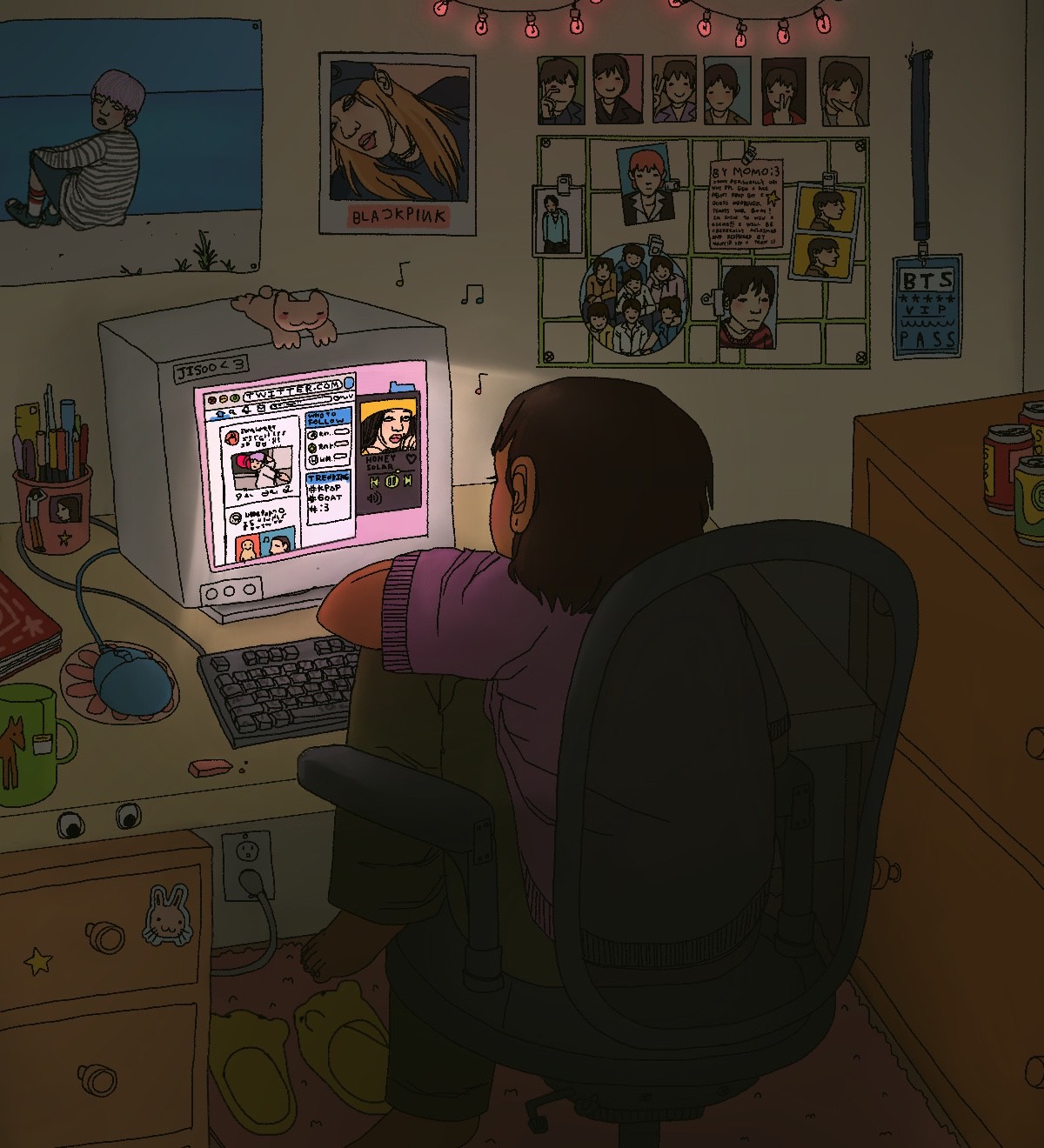My K-pop obsession started with Super Junior’s “Mr. Simple” and “Sexy, Free, and Single.” For four months, I would come home after school and rewatch both music videos on repeat. My viewing habits eventually evolved beyond YouTube. I opened a Tumblr blog just so I could watch that same music video through GIF segments. On Tumblr, I found a community where someone was always willing to talk about K-pop, and I often spent hours scrolling through fan content. Before long, I had joined another dozen or so online groups. I photoshopped edits of my favourite “ships” using my amateur design skills, was heartbroken when Super Junior’s 2014 tour didn’t include my city, and learned the entire choreography of their greatest hits released between 2011 and 2015, just in case I ever needed to showcase my talents. I’d turned into a stan.
A stan is, as Oxford English Dictionary first defined the term in 2018, “an overzealous or obsessive fan, especially of a particular celebrity.” The term was born out of Eminem’s 2000 hit song, aptly titled “Stan.” In it, he narrates the story of an obsessed fan named Stanley. The lyrics are about his desperate plea for Eminem to be his role model. His passion soon spirals out of control, leading to his eventual demise. Another interpretation, as described in an episode of NPR’s All Things Considered, is that the term combines the words “stalker” and “fan.” But, for me, and for many other people of my generation who live in the world of fandom, the term has evolved into a sort of badge of honour. We make fan pages, go to every concert, spend hours online—especially on Twitter—reading through comments about our favourite artists, and are first to come to their defence whenever anyone has anything bad to say.
But what happens when fandom goes too far?
Fame and early instances of “celebrities” go back to the time of the Romans. Famous people at the time were mainly rulers, conquerors, athletes, philosophers, and even medieval saints. The meanings of the words “celebrities” and “star,” as we understand them today, were formed in the eighteenth century, when the public’s interest shifted toward authors, artists, performers, and scientists. Where the earliest celebrities received acclaim mostly after death, modern celebrity status was now conferred during a celebrity’s lifetime. The industrial revolution allowed people to have more leisure time for entertainment and the arts and to see these celebrities in person, helping propel celebrity culture to its current levels.
The onset of social media made our connections to these people feel more intimate. With near unlimited access to the artists we admire—be it on Twitter, Instagram, or TikTok—we are constantly bombarded with news and updates about them, making it easy to indulge in their lives. From Bella Hadid’s crying selfies to Justin Bieber’s bubble bath photos, it seems like there’s really no limit to what celebrities will post. As Suwan Juntiwasarakij, director of the digital innovation graduate program at Thammasat University in Bangkok, wrote in a 2017 article, “It is ‘celebrity on steroids’ when celebrities meet with social media”—which might help explain why some fans experience such a deep and emotional attachment to an artist. These parasocial, one-sided relationships are often exaggerated by artists telling their fans they love them, hosting regular live broadcasts and allowing fans to “message” them through subscription-based apps. This can create a sense of delusion, where fans not only start to feel protective about certain celebrities but also feel the need to compete to prove their devotion. In extreme cases, they cross lines and end up participating in online harassment.
In 2018, after the rapper CupcakKe tweeted a series of sexually explicit things about BTS member Jungkook, stans sent her death threats. Beyonce’s “Beyhive” also came for Nicole Curran, wife of the owner of the basketball team Golden State Warriors, after a video was circulated of her leaning over Beyonce to speak to Jay-Z at a game. Stans accused her of being rude (“The audacity to talk across the Queen,” wrote one commenter, according to the BBC), harassed her to the point of tears, and forced her off Instagram.
Stan Twitter, especially, has become a vicious breeding ground for trolls and an enabler of bullies—even among fellow fans. “The problem comes when people weaponize their enthusiasm and community as a way to attack or harm others that don’t agree,” Keidra Chaney, editor-in-chief of a publication called The Learned Fangirl, wrote in an email. Anyone who, like me, has spent time in the deepest pits of stan Twitter knows just how alarming the things people say can be. Some are quick to accuse others of not being “real” fans based on how long they’ve been part of the fandom, how much they’ve contributed to streaming, their financial contribution to helping groups, or how many concerts they’ve seen. There’s name calling, derogatory language, slurs, and death threats over simple criticisms—all in order to get the upper hand in a measly argument online.
Chaney adds that fandom can also be problematic when it becomes disruptive to someone’s day-to-day life or to the relationships with the people they care about. “It’s easy to get so invested in it that you stop focusing on your identity outside of the community you love,” she wrote. That can have all kinds of negative consequences. Several studies have shown a negative correlation between celebrity worship and anxiety. One of those studies, published in the journal Innovations in Clinical Neuroscience in 2014, found that those who exhibit higher levels of celebrity worship—many of whom are teens—also have higher levels of depression and social dysfunction as well as body-image problems and lower levels of life satisfaction. These can interfere in one’s real-life relationships and interactions, often leading to social isolation and loneliness.
“Spending time to refocus that energy on a non-social media or fandom-based hobby is a great way to recenter yourself,” wrote Chaney. In other words, fans need to take breaks. No matter how much you love something, it’s important to engage with it in moderation.
At the end of the day, fandoms are grey areas: on the one hand, they can be a place where you can really belong and feel included but, on the other, they can also take over your life. As for myself, I still love K-pop but interact with the community in a different way than when I first got involved.
If there is anything I’ve learned by being online as a K-pop fan, it’s that sometimes it’s better and healthier to enjoy things from afar. I’ve had times where I have distanced myself from the community, but something always pulls me back. Eight years later, now a university student and an adult who has to pay bills and fill gas in the car, I don’t feel that old, but the countless memories that resurfaced while writing this piece were enough to make me feel emotional. K-pop got me through my teen years, and I hope it stays with me during my adult years as well. Something that I remind myself about often is that being a fan and consuming art shouldn’t feel burdensome, stressful, or tiring; it isn’t a 9–5 job, and there’s no reason to make it one. I have days when I feel like I should be more involved online, but I do continue to support my favourite groups in my own ways, like standing outside in the cold for nearly three hours to buy their official tour merch. Fandoms come in many shapes and forms, and as Chaney reminds me, there isn’t just one way to be a fan.




